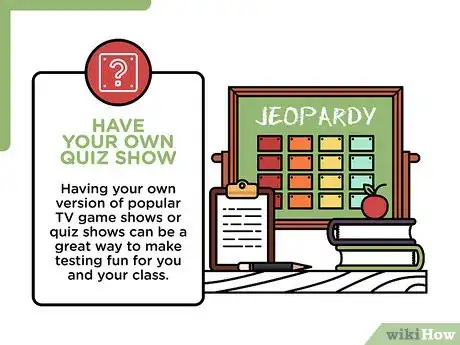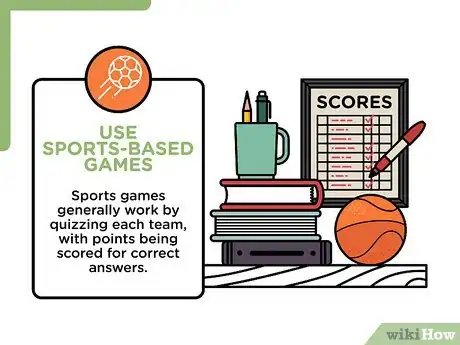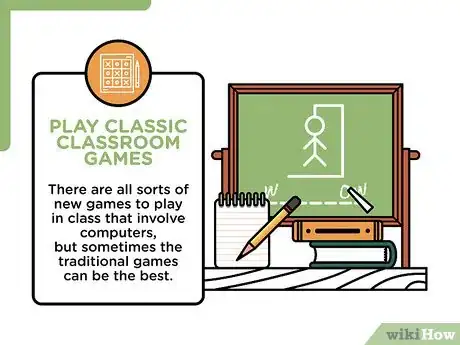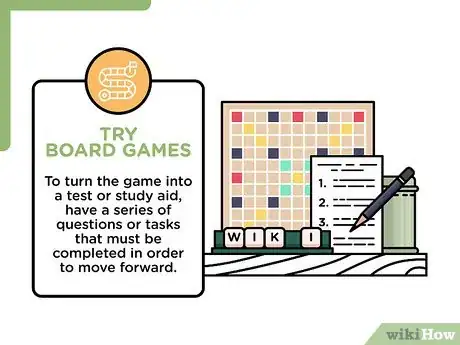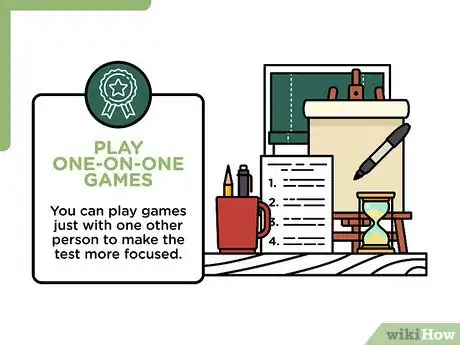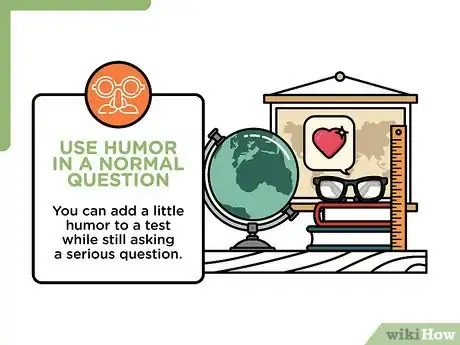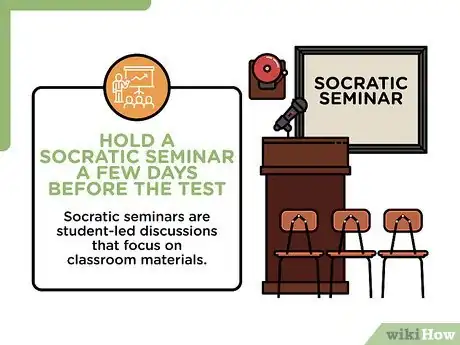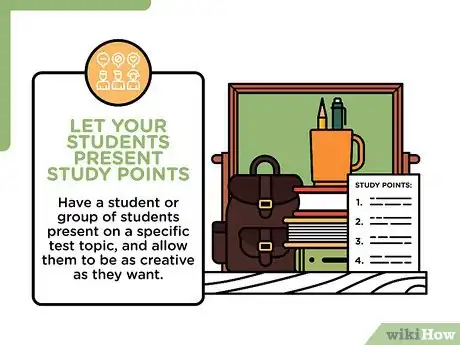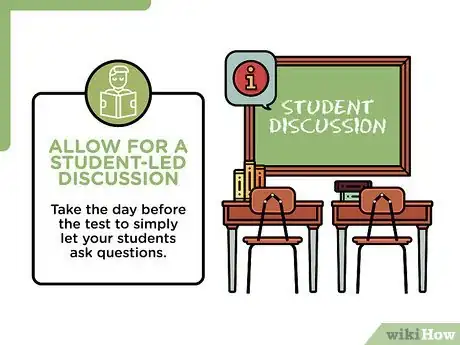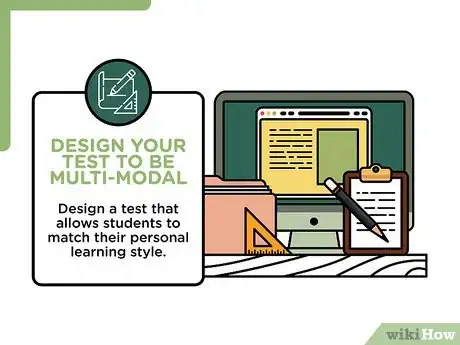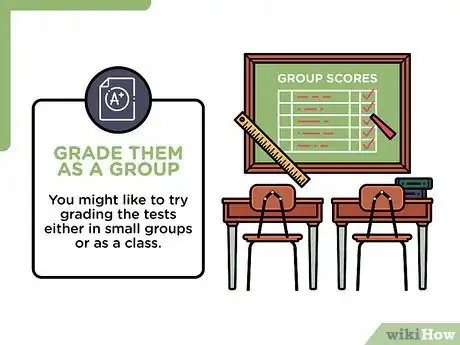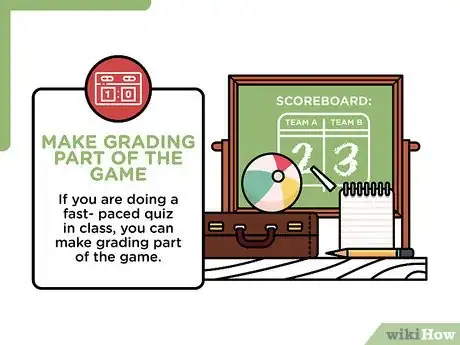This article was co-authored by Emily Listmann, MA. Emily Listmann is a private tutor in San Carlos, California. She has worked as a Social Studies Teacher, Curriculum Coordinator, and an SAT Prep Teacher. She received her MA in Education from the Stanford Graduate School of Education in 2014.
There are 15 references cited in this article, which can be found at the bottom of the page.
This article has been viewed 54,908 times.
Tests are a central part of learning and checking your knowledge. Often they involve sitting in silence with a test-sheet. There are, however, ways to make tests, and studying for tests, more fun. Try to turn tests into quizzes or challenges, and play with friends and classmates. Introducing some friendly competition can make the tests more engaging.
Steps
Playing Games in Teams
-
1Have your own quiz show. Having your own version of popular TV game shows or quiz shows can be a great way to make testing fun for you and your class. You will have to think of your favorite shows, and which ones you could translate into your classroom. There are a number of templates that have been created and uploaded onto the internet as teaching aids. You can download and use these templates, and adapt them to suit your needs.[1]
- Popular shows like “Jeopardy”, “Who Wants to Be a Millionaire” and “The Weakest Link” are just a few of the options you could go for.
- You can search online for a model for a specific game show, or visit a site that has a few different examples for you to try out.[2]
- These games will typically run on PowerPoint, so they are easy to introduce to the classroom.
- You could also use these games as a study aid when you are working at home.
-
2Use sports-based games. If you are more into sports than game shows, you can use a variety of sports-based games to make your testing and studying more fun and engaging. There are games you can access online related to basketball, football, and baseball amongst others.[3] Sports games generally work by quizzing each team, with points being scored for correct answers.
- For example, one PowerPoint basketball game works by allowing a shot for each correct answer.
- The game will keep track of the scores for each team.[4]
Advertisement -
3Play classic classroom games. There are all sorts of new games to play in class that involve computers, but sometimes the traditional games can be the best. If you are trying to learn vocabulary for a foreign language, try playing Hangman or Pictionary. These are easy games that the whole class can participate in.[5]
- You could introduce a rule in Hangman whereby you have a get a question right before you can guess a letter.
- You could play these games as a whole class, or split up into smaller groups.
- Working in smaller groups might make it easier to ensure that everyone gets involved and participates.
-
4Try board games. You can use classic board games to make testing more fun. Pick straightforward games, such as snakes and ladders, rather than a more complicated game. To turn the game into a test or study aid, have a series of questions or tasks that must be completed in order to move forward.
- For example, if you were playing snakes and ladders you would be asked a question by the teacher before you could roll the dice.
- You could split the class into a few teams and have a prize for the team that gets to the end of the board first.
- The smaller the groups, the more questions each person will have to answer.
-
5Let the students ask the questions. Sometimes a quiz or test can be more fun and engaging if the students themselves are coming up with and asking the questions. One way to do this is to split the class into two groups and give them a short time to think of a certain number of questions on a set topic.
- Each group then takes it in turns to ask the other group of a question.
- For every incorrect answer, the team loses one of their members.
- The team with the last remaining member wins.
Playing Games as Individuals
-
1Play one-on-one games. You can play games just with one other person to make the test more focused. These games will work in the same way as those involving the whole class but will require each person to answer more questions. Some examples of games that can easily be turned into one-on-one tests are Battleships and Connect 4.
- For each turn a player must get a question correct before picking a square to hit in Battleships or a place to add a chip in Connect 4.
- If you are doing this in class, you could make a regular feature at the end of the lesson.
- You could create a tournament or league table from ten-minute games of Connect 4.
- Remember that you will need a lot more questions with the answers prepared to keep it going.
-
2Do quick quizzes online. There are lots of online quizzes that you can take to help you with your studying. Short quizzes can be a good way to break up the monotony of studying. They can also help you assess your knowledge, identify any weak areas, and give you practice of working with a time limit. Set aside ten minutes at the end of each study session for a quick quiz.[6]
- Research suggests that multiple choice tests that offer a gaming element are often more fun and engaging for students.[7]
- Try to set goals and have rewards for good results.
-
3Try a PowerPoint game. If you want something a little different from a normal quiz, you can try out some PowerPoint games. These are like the games you might play in class, but are designed to be played on your own when you are studying.[8] Games will often give you a scenario and a path that you can progress down by getting multiple choice questions right.
- In one example, you will have to maneuver a spaceship and complete a rescue mission.[9]
-
4Add a joke question. You make tests a bit more fun by adding in a jokey question at the end. Having a joke question at the end of a test can be a nice surprise that helps you relax when you reach the end of the exam.[10] An example of a joke question could be:
- Q. How many psychiatrists does it take to change a light bulb?
- A. One, but the bulb has to want to change.
- B. None, the bulb has to change itself.
-
5Use humor in a normal question. You can add a little humor to a test while still asking a serious question. For example, you could frame a maths question so that it is about a celebratory. You can alter a question that asks "an object falls at 10m/s from a height of 250m. How long does it take to reach the ground?"
- A funnier version could be "I pushed Justin Bieber off a cliff 250m high, and he fell at a speed of 10m/s. How long did he take to hit the ground?"[11]
Letting Students Direct Study
-
1Hold a Socratic seminar a few days before the test. Socratic seminars are student-led discussions that focus on classroom materials. In these environments, you help direct content, but students lead the discussion by posing their own questions and having their peers answer. This allows them class time to essentially have a study group.[12]
- Prior to the seminar, you may want to prepare some materials on key points the students should focus on for the test.
- Socratic seminars are particularly useful if your test will have more short answer and essay questions than multiple choice.
-
2Let your students present study points. Assigning a lecture to a student probably doesn't sound fun, but allowing them to get creative and share study materials can be. Have a student or group of students present on a specific test topic, and allow them to be as creative as they want. This gives them the chance to embrace the material while having fun and expressing themselves.[13]
- For example, if you teach European History a suggestion you could offer to your class is a newlywed game skit for the wives of Henry VIII. Ask your students to hit on three or four key aspects of each wife's life, then let them run with the concept.
-
3Allow for a student-led discussion the day before the test. Take the day before the test to simply let your students ask questions. Don't prepare points like you would for a Socratic seminar. Try to keep a low-stress, informal environment where your students are comfortable asking questions and exchanging ideas.[14]
- A true student-led discussion not only helps your students prepare in a relaxed, low-stress environment, it lets you know what material they are comfortable with and what they do not feel prepared to address.
-
4Design your test to be multi-modal. Using the feedback you get from your seminars and discussions, design a test that allows students to match their personal learning style. Try to provide options that don't just rely on writing as proof of concept.[15]
- For example, you may provide a general prompt and allow students the option of a one-on-one oral discussion, writing an essay, or drawing a picture and writing a paragraph explaining the concept.
- This gives written, oral, and visual communicators different outlets to demonstrate the same concepts.
Grading Fun Tests
-
1Debrief and evaluate the tests. Fun quizzes and tests can be a great way to do something a little bit different in the classroom, while still learning and teaching. To make the whole exercise a success, it's important that you don't overlook the evaluation and debriefing at the end of the test. This helps the students to appreciate the purpose of the game and what they learned.[16]
- You can start this by recapping some of the key points covered in test and writing them on the board.
-
2Grade them as a group. You might like to try grading the tests either in small groups or as a class. If you have done the quiz in small groups in class you can swap answers with another group, so that each team marks another team's test. If different groups have different answers to a question, you can use this as an opportunity to discuss it as a class.
- Discussing the question in detail with the different answer will enable you to help make sure that everyone understands which answer was correct and why.
- Encourage the group that got the question wrong to talk together to explain where they went wrong.[17]
- This can operate as a kind of simple peer assessment, where students mark each other's work. This can be very positive, but you should make sure everyone stays friendly and nobody is singled out.
-
3Make grading part of the game. If you are doing a fast-paced quiz in class, you can make grading part of the game. If you have given your students buzzers or bells to answer questions, you can write up the scores on the board and update them after each question. This will make it more like a quiz show.
- You could have a simple tally chart on the board, or you could have something more creative.
- Each correct score could reveal a letter or part of a picture that the teams have to uncover to win.
-
4Ensure the students understand what credit is attached to the test. It might be a fun test at the end of the term to revise some key material while letting off a bit of steam, or it could be a more serious test that counts towards the overall grade. Whichever way you choose to do the test, make sure that you are clear about it.
References
- ↑ http://www.scholastic.com/teachers/article/make-test-review-fun
- ↑ http://people.uncw.edu/ertzbergerj/msgames.htm
- ↑ http://people.uncw.edu/ertzbergerj/msgames.htm#sports
- ↑ http://people.uncw.edu/ertzbergerj/all-games/march-mayhem.html
- ↑ http://www.witslanguageschool.com/NewsRoom/ArticleView/tabid/180/ArticleId/85/Teaching-Tips-Using-Games-in-the-English-Second-or-Foreign-Language-classroom.aspx
- ↑ http://www.collegexpress.com/articles-and-advice/test-prep/articles/test-taking-tips/test-prep-doesnt-feel-test-prep/
- ↑ http://neoacademic.com/2012/01/12/students-find-multiple-choice-tests-fun-and-rewarding-with-gamification/
- ↑ http://people.uncw.edu/ertzbergerj/msgames.htm#drill
- ↑ http://people.uncw.edu/ertzbergerj/all-games/space-rescue.html
- ↑ http://www.pleated-jeans.com/2013/06/03/18-extremely-funny-test-questions/
- ↑ http://www.pleated-jeans.com/2013/06/03/18-extremely-funny-test-questions/
- ↑ https://www.edutopia.org/blog/socratic-seminars-culture-student-led-discussion-mary-davenport
- ↑ https://www.cmu.edu/teaching/designteach/design/instructionalstrategies/groupprojects/benefits.html
- ↑ /article/improving-student-led-discussions
- ↑ https://www.umassd.edu/dss/resources/faculty--staff/how-to-teach-and-accommodate/how-to-accommodate-different-learning-styles/
- ↑ http://www.witslanguageschool.com/NewsRoom/ArticleView/tabid/180/ArticleId/85/Teaching-Tips-Using-Games-in-the-English-Second-or-Foreign-Language-classroom.aspx
- ↑ https://www.teachervision.com/test/resource/5940.html?page=2
